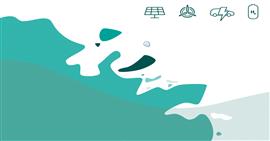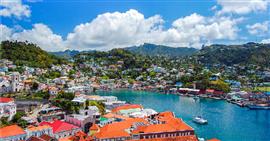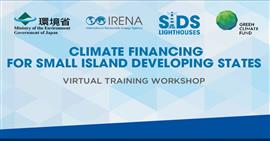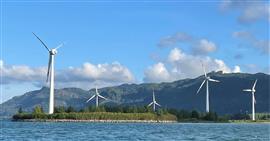


About us

SIDS Lighthouses Initiative
The SIDS Lighthouses Initiative (LHI) is a framework for action to support Small Island Developing States (SIDS) in their energy transition efforts from fossil fuel dependence to renewables. The Initiative brings together 41 SIDS as well as 53 partners, including developed countries, regional and international organisations, development and multilateral agencies, private companies, research institutes and non-profit organisations. IRENA is the coordinator and facilitator of the initiative.
Click here to read more about SIDS LHI Priorities
Download the Annual Progress Report 2025
Partners
Small Islands Developing States (41)
Antigua & Barbuda, Aruba, Bahamas, Barbados, Belize, British Virgin Islands, Cape Verde, Comoros, Cook Islands, Cuba, Curaçao, Dominica, Dominican Republic, Fiji, Grenada, Guyana, Jamaica, Kiribati, Maldives, Marshall Islands, Mauritius, Micronesia (Federated States of), Montserrat, Nauru, New Caledonia, Niue, Palau, Papua New Guinea, Saint Kitts and Nevis, Saint Lucia, Saint Vincent and the Grenadines, Samoa, São Tomé & Príncipe, Singapore, Seychelles, Solomon Islands, Tonga, Trinidad and Tobago, Turks and Caicos, Tuvalu, Vanuatu.
Non-partner Small Islands Developing States (16)
Guinea Bissau, Haiti, Suriname, Timor-Leste, American Samoa, Anguilla, Bermuda, Cayman Islands, Commonwealth of Northern Marianas, French Polynesia, Guadeloupe, Guam, Martinique, Puerto Rico, Sint Maarten, and U.S. Virgin Islands.


Partners (48)
Australia, Denmark, France, Germany, Japan, Italy, The Netherlands, New Zealand, Norway, Malta, United Arab Emirates, United States of America
Airborne Wind Europe, Akuo, Asian Infrastructure Investment Bank, Association of the Overseas Countries and Territories of the European Union, Barefoot College, Caribbean Climate-Smart Accelerator (CCSA), Caribbean Development Bank (CDB), Caribbean Electric Utility Services Corporation (CARILEC), Cheesecake Energy Limited, Clean Energy Solutions Center, Clinton Climate Initiative, DRIFT Energy Ltd, ENEL, European Union, Greening the Islands, Green Solutions International SKN, Island Innovation, Indian Ocean Commission, International Renewable Energy Agency, Islands and Small States Institute (ISSI), Local2030 Islands Network, Organisation of African, Caribbean and Pacific States (OACPS), Organisation of Eastern Caribbean States, Pacific Community (SPC), Pacific Islands Development Forum, Pacific Power Association, Rocky Mountain Institute - Carbon War Room, Solar Head of State, Sustainable Energy for All, Sur Futuro Foundation, The Indian Ocean Rim Association (IORA), United Nations Development Programme, United Nations Office of the High Representative for the Least Developed Countries, Landlocked Developing Countries and Small Island Developing States (UNOHRLLS), University of Delaware, University of Malta, World Bank
Affiliated Partners with Cooperation Agreements and Workplans (7)
Alliance of Small Island States (AOSIS), Caribbean Centre for Renewable Energy and Energy Efficiency (CCREEE), CARICOM Development Fund, Caribbean Community Climate Change Centre (CCCCC), Pacific Community (SPC), SIDS DOCK, UNOHRLLS
How to join
IRENA as the coordinator of the SIDS Lighthouses Initiative (LHI) welcomes partnerships with Small Island Developing States (SIDS) and other partners, including governments, international and regional organizations, non-government organisations (NGOs), financing institutions, research and academic institutes and private sector entities, to work together in strengthening SIDS climate resilience and sustainable development. It is also important to note that becoming a partner of the SIDS Lighthouses Initiative is free of charge.
Please find here the template to guide your Expression of Interest (EOI). The official Expression of Interest (EOI) letter to become a partner of the SIDS Lighthouses Initiative should be addressed to:
Mr Francesco La Camera
Director General
International Renewable Energy Agency
Masdar, Abu Dhabi
United Arab Emirates
The EOI can be emailed to odg@irena.org and copied to islands@irena.org.
Private sector entities interested in joining the SIDS LHI should refer to the IRENA Private Sector Guidelines, which provide detailed information and prerequisites for engagement, collaboration, and partnership with the SIDS LHI. The guidelines can be found here.
Renewable Energy Progress

The trend of adopting innovative solutions, including renewable energy (RE), energy efficiency, and other technologies in SIDS, continues to evolve. The cumulative installed RE capacity increased substantially from 2014 to 2023, rising from 3.7 GW to 8.76 GW. Solar energy exhibited a remarkable increase, growing from 0.1 GW in 2014 to 4.2 GW in 2023. Wind power capacity also grew, doubling from 0.5 GW in 2014 to approximately 1.0 GW in 2023. Additionally, bioenergy capacity expanded by approximately 47%, reaching 1.7 GW in 2023. This accelerated deployment of innovative solutions in SIDS underscores their commitment to a just and equitable energy transition for sustainable development and climate resilience.







